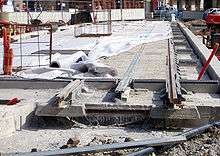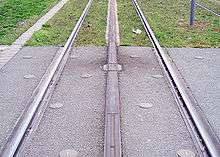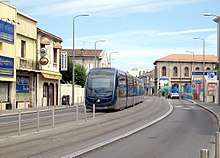Ground-level power supply



Ground-level power supply, also known as surface current collection and Alimentation par le Sol (APS, which literally means feeding via the ground), is a modern method of third-rail electrical pick-up for street trams instead of more common overhead lines, thus it is one of the methods that could allow construction of catenary-free light rail system. It was invented for the Bordeaux tramway (Tramway de Bordeaux), which was constructed from 2000 and opened in 2003. From 2011, the technology has been used as part of other systems around the world, with Reims Tramway, Angers tramway and Dubai Tram all having adopted the technology.
Technology
Ground-level power supply is used, primarily for aesthetic reasons, as an alternative to overhead lines. It is different from the conduit current collection system (which was one of the first ways of supplying power to a tram system) as it involves burying a third and fourth rail in an underground conduit (‘vault’) between the running rails. Conduit current collection was used in historic tram systems in Washington, Manhattan, Paris, Berlin, Marseilles, Vienna, Budapest and London. It fell into disuse because overhead wires proved much less expensive and troublesome for street railways[1] and because in Manhattan, Paris, Washington and West Berlin, all trams were replaced by buses for reasons unrelated to the power supply issue. In Prague on the Charles Bridge (Karlův most), a system invented by František Křižík was used, similar to today's APS.
Unlike the track-side third rail used by most metro trains and some main-line railways, APS does not pose a danger to people or animals and so can be used in pedestrian areas and city streets.
APS uses a third rail placed between the running rails, divided electrically into ten-metre rail segments with three-metre neutral sections between. Each tram has two power collection shoes, next to which are antennas that send radio signals to energise the power rail segments as the tram passes over them. At any one time, two consecutive segments under the tram will be live.
Use in Bordeaux
Modern ground-level current collection was pioneered by the Bordeaux tramway in France. The public had assumed that the new system would use a traditional conduit system, like that of the Bordeaux trams which ran prior to 1958 and objected when they learned that it was not considered safe and that overhead wires were to be used instead. Facing complaints both from the public and the French Ministry of Culture, planners developed APS as a modern way of replicating the conduit system.
APS was developed by Innorail, a subsidiary of Spie Enertrans but was sold to Alstom when Spie was acquired by Amec.[2]
There are 12 km of APS tramway in the three-line network of 43.3 km as of 2008. Bordeaux Citadis trams use pantographs and electric overhead lines in outlying areas.
Before use in Bordeaux, APS was tested and proved viable on a short section of reserved-track in the French city of Marseille. Nevertheless, Bordeaux has experienced problems, with APS being so temperamental that, at one stage, the Mayor issued an ultimatum that if reliability could not be guaranteed, it would have to be replaced with overhead wires.
Problems have included water-logging, when the water does not drain quickly enough after heavy rain.
In other cities
In July 2006, it was announced that two new French tram systems would be using APS over part of their networks.[3] These are located in Angers[4] and Reims, with both systems opening in 2011. A couple of months later, it was announced that Orléans would use APS on a section of its second tram line, which opened in 2012, and that Tours would use APS on sections of its new network which began service in 2013.[5]
APS is also in use in two other tram systems outside France. The first of these, the Dubai Tram opened in 2014, is fully equipped with APS over its entire passenger route length,[6] and thus trams do not use their pantographs unless travelling within the depot area. In June 2016, the first phase of the VLT Carioca network opened in Rio de Janeiro, Brazil. This system mainly uses APS, however where this was deemed impractical, the trams employ SRS, Alstom's proprietary supercapacitor-based energy storage system (SRS).[7]
Alstom is currently installing APS in two other tram systems: the CBD and South East Light Rail line in Sydney, Australia,[8] and the Tranvía Cuatro Ríos de Cuenca in Cuenca, Ecuador.[9] Both lines are planned to use APS in certain regions only and conventional overhead wires elsewhere.
In 2017, another ground-level power supply technology, TramWave, developed by Italian company Ansaldo, successfully entered commercial application via the opening of Zhuhai tram Line 1 first phase in China, and it is said to be the first 100% low-floor tram system adopting ground level power supply technology.[10] Later in the year, Western Suburb Line in Beijing will also be opened with the same technology from Ansaldo.[11] The technology have been licensed to CRRC Dalian and all the technologies were transferred to China.[12]
Other cities that have previously, or are in the process of proposing the use of APS and similar systems (e.g.Ansaldo TramWave) include:
- Nice, France (abandoned in favour of nickel metal hydride batteries)
- TRAMMET, Barcelona, Spain[13]
- Gestione Servizio tramviario (GEST), Florence, Italy
- Tramway de Marseille, Marseille, France
- Environmentally Friendly Linkage System, Hong Kong - proposal by opponents of the monorail system to use APS instead.[14]
Similar systems
Stud contact
The predecessors of APS (known as stud contact systems) were developed around 1900, and used by several tramway companies in Paris and in England. Associated with these systems were the inventors Dolter and Diatto.
There were two main differences from APS:
- Power was supplied not from rails but from studs, set in the road at intervals
- Switching in of the contacts was done by strong electromagnets beneath each car. Each contact contained a fuse, which would be blown by an earthed safety shoe on the rear of the tram should the contact not have switched out. This proved to be unsatisfactory because the strong currents melted down the switch contacts, resulting in contacts frequently remaining 'live'.
Prague
In Prague, a ground-level power supply was applied at the experimental, recreational and promotional tram line operated by the Czech inventor and entrepreneur František Křižík at Letná hill. It was the first electrically-powered tram line in the Prague agglomeration. The track was operated between 1891–1900; however the ground-level power supply was tested there only in early 1896 on one part of the track. Power was supplied through a third rail but a system of contact relays ensured that voltage was there only when a car was directly above. A commission recommended the system be extended to the whole track but it was never realized.
In 1905, a similar system by František Křižík was used on the Charles Bridge. This section was the last one with horse-drawn trams, due to disapproval of overhead lines there. Ground-level supply made it possible to electrify this track. However, the weight of the trams caused damage to the bridge due to vibrations, which is why they were replaced by rail buses in 1908. These were stopped in 1909. In 1932–1939, classic buses on tyres were operated there. Since 1965, Charles Bridge has been a pedestrian-only zone.
Budapest
Another system of ground-level power supply was used by Budapest trams from 1887. Overhead lines were considered an eyesore, so builder Siemens developed the following system: on the inner side of one rail, a powered third rail was hidden underground in a half-covered ditch, with a narrow slit opening upwards, through which a trolley pole reached downward from the trams. The Budapest system was generally safe and water-protected. However, there was no defence against snow and ice, dirt filled up the ditches and trolley poles suffered intense wear. Overhead wire replaced the "Budapest system" everywhere by the 1920s.
Conduit
Conduit current collection has the power supply carried in a channel under the roadway between the running rails, much in the same fashion as the cable for cable cars.
Stream system
Stream is an acronym that stood for "Sistema di TRasporto Elettrico ad Attrazione Magnetica" ("System of Electric Transport by Magnetic Attraction"). The channel made of composite material was thus insulating the vehicle equipped with a special shoe on the passing magnetic channel raised the band allowing contact with the copper strip and then the electrical connection.
See also
References
- ↑ Post, Robert C. (2007). Urban Mass Transit: The Life Story of a Technology. Greenwood Press. pp. 45–47. ISBN 0-313-33916-3.
- ↑ "Third-rail trams across the Garonne". Railway Gazette International. 2004-02-01. Retrieved 2008-05-02.
- ↑ "Reims and Angers choose APS". Railway Gazette International. 1 August 2006.
- ↑ "Angers tram opens". Railway Gazette International. 29 June 2011.
- ↑ "Tours selects Citadis and APS". Railway Gazette International. 2010-09-14.
- ↑ "Al Safouh tram project consortium selected". Railway Gazette International. 2008-04-29. Retrieved 2008-05-02.
- ↑ Wright, Sarah. "Alstom opens Rio's tramway ready for the 2016 Olympic Games". Retrieved 2017-11-04.
- ↑ "Archived copy". Archived from the original on 2014-12-14. Retrieved 2014-12-02.
- ↑ UK, DVV Media. "First Cuenca tram on its way". Railway Gazette. Retrieved 2017-11-04.
- ↑ 历经磨难 全球首个地面供电的100%低地板现代有轨电车项目终成正果
- ↑ 去颐和园、香山更方便啦!西郊线年底运营,还能和地铁换乘
- ↑ 中国首次引进现代有轨电车技术(图)
- ↑ "El Consistorio planea un tranvía sin catenaria por la Diagonal". El País. 2008-09-09. Retrieved 2008-10-19.
- ↑ http://www.scmp.com/news/hong-kong/article/1225440/tram-may-suit-kai-tak-better-monorail-operator-says
External links
| Wikimedia Commons has media related to Alimentation par le sol. |